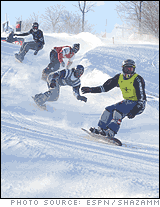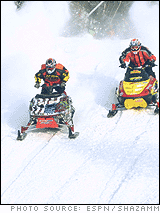Winter X Games 2003
Updated February 21, 2017 | Factmonster Staff 

Rocky Mountain High
A guide to the 2003 Winter X Games
 |
After two years at Mt. Snow in Vermont, the Winter X Games returned to Colorado in 2002 and will be held there again in 2003.
The games, which were dreamed up by the sports television network ESPN, first took place in Bear Lake, Calif., in 1997, and spent two years in Crested Butte, Colo., before moving to Vermont in 2000. The 2002 Winter X Games were held at Buttermilk Mountain in Aspen, Colo. The 2003 games will be head at Buttermilk from Jan. 30–Feb. 1 and will include over 300 athletes from all around the world.
The games incorporate four major winter sports disciplines for men and women that—for the most part—you won't find in the Winter Olympic Games, but you will come across on some recreational slopes.
The games will be televised on ESPN, ESPN2, and ABC from Jan. 30–Feb. 4.
The games, which were dreamed up by the sports television network ESPN, first took place in Bear Lake, Calif., in 1997, and spent two years in Crested Butte, Colo., before moving to Vermont in 2000. The 2002 Winter X Games were held at Buttermilk Mountain in Aspen, Colo. The 2003 games will be head at Buttermilk from Jan. 30–Feb. 1 and will include over 300 athletes from all around the world.
The games incorporate four major winter sports disciplines for men and women that—for the most part—you won't find in the Winter Olympic Games, but you will come across on some recreational slopes.
The games will be televised on ESPN, ESPN2, and ABC from Jan. 30–Feb. 4.
Snowboarding and Skiing: Slopestyle
Men and women snowboarders and skiers compete separately on a snow-packed obstacle course and are awarded points for their performances. Judges base their scores on the quality and quantity of jumps hit, as well as how well the competitors incorporate the man-made obstacles into their run. The obstacles, things like handrails and picnic tables, are similar to those found on skateboarding courses. More points are awarded for difficult and creative tricks that impress the judges.
|
Skier X and Snowboarder X
Both of these disciplines have women and men compete separately in heats of six. The "X races" are races of speed. Scattered along these winding downhill courses are high-mounded curves (called berms) and sets of moguls (called whoop-de-dos or whoops) that add a significant challenge to the run. Also, limited contact is allowed between racers. The top finishers from each heat move on to the next round, much like you would see at a track-and-field event.
Snowboarding and Skiing: SuperPipe
Men and women compete on a U-shaped ramp carved into the snow. This event has been upgraded to superpipe status (as opposed to halfpipe status) because the ramp is 14 feet tall on either side, 2–3 feet larger than the traditional halfpipe ramp. Snowboarders and skiiers are judged on the tricks they perform in, on, and above the pipe.
Ultracross
|
The top 16 fastest skiers and snowboarders at the games compete in a team relay-style event on the Skier X course. The pairs are chosen at random, but one must be a skier and one a snowboarder.
Organizers hope this event, introduced in 2000, will help ease the unspoken rift between skiers and boarders—a rift that began when snowboarders first broke away from their skiing ancestors in the mid-1980s. In any case, the snowboarders race the first leg, and as they cross the finish line a computer chip timing device triggers the starting gate for their skiing partner. The team with the best combined time wins the race.
Organizers hope this event, introduced in 2000, will help ease the unspoken rift between skiers and boarders—a rift that began when snowboarders first broke away from their skiing ancestors in the mid-1980s. In any case, the snowboarders race the first leg, and as they cross the finish line a computer chip timing device triggers the starting gate for their skiing partner. The team with the best combined time wins the race.
Snowmobiling
 |
The first of the two snowmobiling events is SnoCross. It's like NASCAR auto racing on the snow. The course is not an oval; it is a winding snow-covered trial that goes uphill one minute and down the next. The top 16 qualifiers face off in two eight-snowmobile final runs with the fastest driver of these two furious groups winning the gold medal.
The HillCross event is similar to the X races, only instead of racing downhill on skis or snowboards, drivers are powering their snowmobiles uphill. The fastest to the top of the course wins.
The HillCross event is similar to the X races, only instead of racing downhill on skis or snowboards, drivers are powering their snowmobiles uphill. The fastest to the top of the course wins.
Moto X
The Moto X Big Air event typifies the X-games mentality. This spectacle brings together motorcycles and ski jumping—two things that have no business being combined. Competitors speed off a 15-foot ramp and perform tricks over a 70-foot gap in the hill, trying hard to impress judges and dazzle spectators.
See also:
